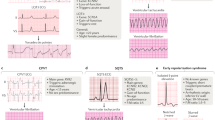Summary
The molecular genetic background of inherited cardiac arrhythmias has only recently been uncovered. This late development in comparison to other inherited cardiac disorders has partly been due to the high mortality and early disease onset of these arrhythmias resulting in mostly small nucleus families. Thus, traditional genetic linkage studies, which are based on the genetic information obtained from large multi-generation families, were made difficult. Inherited arrhythmogenic disorders can be divided into ‘primary electrical disorders’ (e.g., long-QT [LQT] syndrome) in which a detectable, organic heart disease is not evident, and into inherited diseases of the myocardial structure (e.g., hypertrophic cardiomyopathies) in which the arrhythmias occur combined with the structural alterations.
To date, all inherited arrhythmogenic disorders in which the causative genes have been identified turned out to be channelopathies, since the genes encode channel subunits that regulate important ion currents that tune the cardiac action potential. The discovery of the genetic bases of the LQT syndrome became a now methodologic paradigm; because with the use of ‘classical’ genetic linkage strategies (named [positional] candidate strategies) not only the causative genes have been found, but moreover, functional components with a previously unknown but fundamental role for a normal repolarization process were discovered. Disease mutations turned out to be not only a family-specific event with a distinct phenotype and the potential of an additional diagnostic tool, but also, when expressed in heterologous expression systems, characterize the defective ion channel in a topological way and lead to a more specific understanding of ion channel function.
Most, if not all, primary electrical cardiac disorders show a high genetic diversity. For the LQT syndromes, sixth disease loci and the responsible gene have been recently discovered (socalled locus or genetic heterogeneity). Within all disease genes, the mutations are spread over the entire gene (allelic heterogeneity); in addition, more than one disease mutation may be present. This complexity requires, at least, complete mutation analysis of all LQT genes before medical advice should be given.
Meanwhile, genotype-phenotype correlations in large families are being used to evaluate intergene, interfamilial and intrafamilial differences in the clinical phenotype, reflecting gene specific, gene-site specific and individual consequences of a given mutation. A widespread phenotypic heterogenity even within mutation carriers in the same family raises the importance of modifying factors and genes that are mostly unknown to date. The reduced penetrance and variable expressivity associated with the LQT mutations remain still to be explained. First insights into the complex actions of mutations are being extracted, from expression data; these preliminary results may lead to potential implications for a specific (gene-site directed) therapy.
This paper discusses the current data on molecular genetics and genotype-phenotype correlations in LQT syndrome and related disorders and the potential implications for diagnosis and treatment.
Similar content being viewed by others
Author information
Authors and Affiliations
Rights and permissions
About this article
Cite this article
Schulze-Bahr, E., Haverkamp, W., Borggrefe, M. et al. Molecular genetics of arrhythmias – a new paradigm. Z Kardiol 89 (Suppl 4), IV12–IV22 (2000). https://doi.org/10.1007/s003920070059
Issue Date:
DOI: https://doi.org/10.1007/s003920070059




